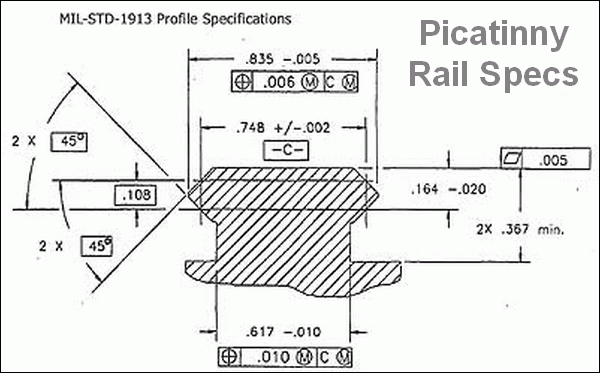Weaver vs. Picatinny Scope Rails

Readers often ask “What’s the difference between a Weaver scope rail and a Picatinny Rail?” The answer is not as simple as it seems. The dimensions of a Picatinny Rail should be consistent (from one rail-maker to another), since there IS a government spec. Conversely, there is some variance in “Weaver-style” rails. The width of the groove is the most important difference between Picatinny Rails and weaver rails. “Mil-spec” Picatinny rails will have a grove width of 0.206″ while Weaver rails typically have a narrower, 0.180″ groove width.
Brownell’s has a helpful GunTech™ Article that discusses the Picatinny Rail vs. Weaver Rail. That article explains:
“What are the differences between the ‘Picatinny’ and the ‘Weaver’ systems? The profile of the two systems is virtually identical. Depending on the quality of the machining done by the manufacturer, the two systems should be indistinguishable from the profile. The key difference lies in the placement of the recoil grooves and with width of the grooves. MIL-STD-1913 (Picatinny) grooves are .206″ wide and have a center-to-center width of .394”. The placement of these grooves has to be consistent in order for it to be a true ‘Picatinny’MIL-STD system. Weaver systems have a .180” width of recoil groove and are not necessarily consistent in a center-to-center measurement from one groove to the next.

In many instances, a Weaver system has a specific application that it is machined for, so interchangeability is not necessarily an issue. A MIL-STD-1913 system must adhere to the specifications listed above in order for it to be considered MIL-STD, since the military desires uniformity in the recoil grooves to allow for different systems to be mounted on the weapon with no concern for compatibility.
Now, what does this mean to you? Boiled down, it means that accessories designed for a Weaver system will, in most cases, fit on a ‘Picatinny’ system. The reverse, however, is probably not the case. Due to the larger recoil groove, ‘Picatinny’ accessories will not fit a Weaver system. There are, of course, exceptions to every rule, but for a good rule-of-thumb, [full-width] ‘Picatinny’ won’t fit Weaver, but Weaver will fit ‘Picatinny’.”
Similar Posts:
- TECH TIP: Picatinny vs. Weaver Rail Specifications
- Weaver Rail vs. Picatinny Rail — What’s the Difference?
- Weaver Rail vs. Picatinny Rail — What Are the Differences?
- Scope Ring Cap with Built-In Picatinny Rail — Clever Innovation
- Stud Rail Adapter Mounts Picatinny Rail on Sling Swivel Stud
Tags: Mil 1913, Picatinny, Scope Rail, Weaver


















I have found that the various picatinny rails are not consistent and frequently have to adjust scope rings to move a scope from one rifle to another. This includes AR type rifles in the mix. I have not taken the time to see which ones are the same and which ones are not.
One little caution, that relates to this story, is that although it is generally true that Weaver rings will fit Picatinny scope bases, in a couple of cases, I have found that the Burris Z rings, including the Signature variant did not open far enough to slip on a Picatinny base. If you are going to use these rings, I suggest that you match them with a Weaver base. Weaver rings that clamp with a separate piece rather than by bending the ring body at a weakening cut, as the Zs do, do not have this problem.
Burris Z-rings are not bad,but I would like to see Burris add an upgraded
Z-ring using a clamp plate in place of
that slot. Some people are just a tad
turned off with that deep slice.
This is very informative and an issue I recently discovered when my bi pod attachment didn`t want to fit properly on my rail on my superb Elseo CG 1 stock.
The Main advantage to Picatinny systems as I see it,(I now make my own Mil Spec. Picatinny Rails) is that if you put true Picatinny Rails on all your Match Rifles, and when I say true I mean true to the pitch of the lug and slot size, Then any scope you have mounted on any rifle can be switched to another rifle without moving the rings for spacing. Also, while they switch nicely they will have to be sighted in for the new rifle. Another atribute is that when placed on a muzzle loading firearm, the scope can be removed to clean the rifle, and replaced easily. This keeps the scope out of the sink, etc.
Paul
The top drawing was superseded by Change NOTICE 1, 10 June 1999, which adds a max .060 radius at the bottom of the .367 dimensioned feature. See http://elr-resources.com/MIL-STD-1913_CHG_NOTICE-1.pdf